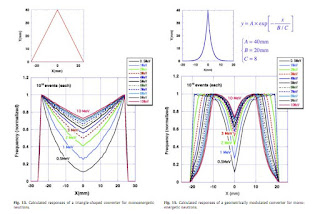In radiation detection, one of the most challenging aspect is the design of appropriate detectors / sensors that can provide some tell tale sign of the signature of the radiation being probed. In Spectrum Unfolding and L1 Minimization ?, I mentioned that some techniques are being currently employed in the field that parallels some of the effort in compressive sensing. Specifically, in the case of neutron spectroscopy, for example, the method for reconstructing neutron energy information (the neutron spectrum) is through the use of several detectors (they're called Bonner spheres after a leading researcher in the field ailing from, once again, Rice University). The MAXED technique employed is just a Bayesian fitting of the result of these measurements and the computations performed on models through codes such as MCNPX. But while this fitting of underdetermined experimental data to models is well known, it does not address a more salient point that should be made from a compressive sensing standpoint: Is there a need to change the Bonner spheres into something more "exotic" so that the acquisition of the data provide some compressed information on the neutron spectrum ? and How can compressive sensing lead in the design of such detectors ?
Here is an element of an answer. As I was reading through the literature, I found the following interesting and recent paper [1]: A method of neutron energy evaluation by using an imaging plate and cone-like acryl converters with a geometrical modulation concept by A. Nohtomi, N. Sugiura, T. Itoh, G. Wakabayashi, T. Sakae, T. Terunuma, K. Yabuta, M. Tamura, T. Fujibuchi, T. Takata, K. Kume. The abstract reads:
Cone-like acryl converters have been used for transforming the energy-distribution information of incident fast neutrons into the spatial-distribution information of recoil protons. The characteristics of neutron–proton conversion have been studied up to around 10 MeV by using an imaging plate (IP). A notable and interesting signal enhancement due to recoil protons generated in an acryl converter was observed on IP images for irradiation with a 252Cf source. Similar experiments were also performed in the radiation field of a research nuclear reactor and an accelerator-based neutron generator. A Monte Carlo calculation was carried out in order to understand the spatial distributions of the signal enhancement by recoil protons; these distributions promisingly involve the energy information of incident neutrons in principle. Consequently, it has been revealed that the neutron energy evaluation is surely possible by analyzing the spatial distributions of signal enhancement that is caused by recoil protons.
In terms of detector design this is very refreshing as not much progress has been done beyond the Bonner spheres. The authors first show how unsymmetric pieces of converters can produce different spectrum curves thereby allowing a discretization of the energy flux.
In other words, while this system aims at directly unmixing the different component of the neutron flux, we could also conceive a similar type of set up where the different components of the flux are multiplexed with each other at different locations of the detector thereby providing a good compressive sensing measurement matrix.
On a related matter, this study on The Effect of Bonner Sphere Borehole Orientation on Neutron Detector Response by John Brittingham shows how the coefficients in the measurement matrix might be sensitive to the actual location of details such as the borehole letting the electronics inside the detector.
Reference:
[1] A method of neutron energy evaluation by using an imaging plate and cone-like acryl converters with a geometrical modulation concept by A. Nohtomi, N. Sugiura, T. Itoh, G. Wakabayashi, T. Sakae, T. Terunuma, K. Yabuta, M. Tamura, T. Fujibuchi, T. Takata, K. Kume. Nuclear Instruments and Methods in Physics Research Section A: Accelerators, Spectrometers, Detectors and Associated Equipment, Volume 633, Issue 1, 21 March 2011, Pages 36-45



No comments:
Post a Comment